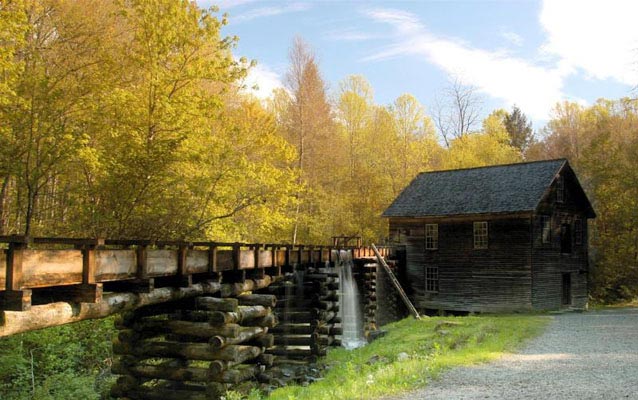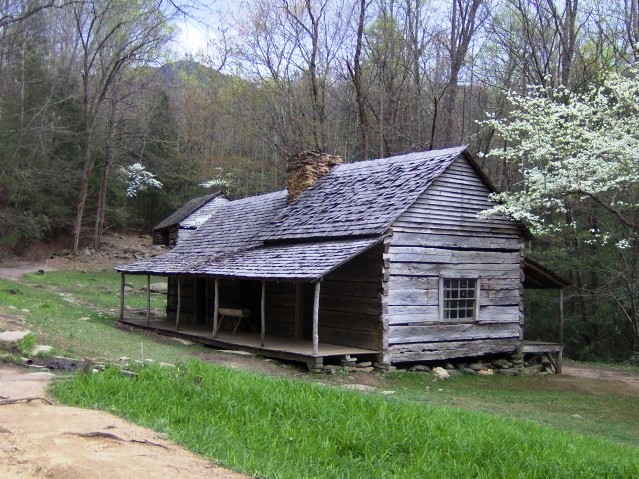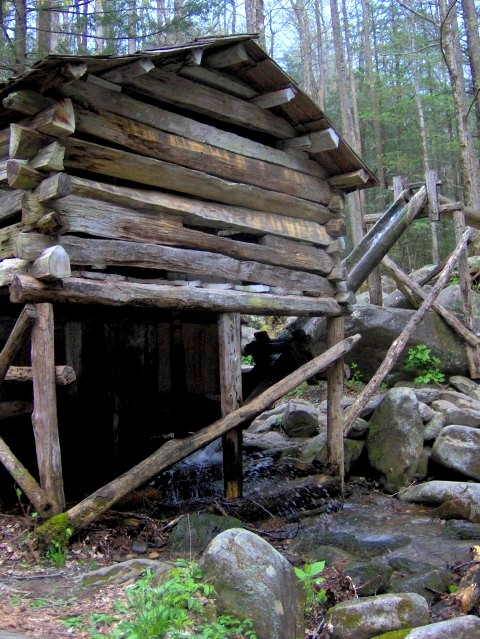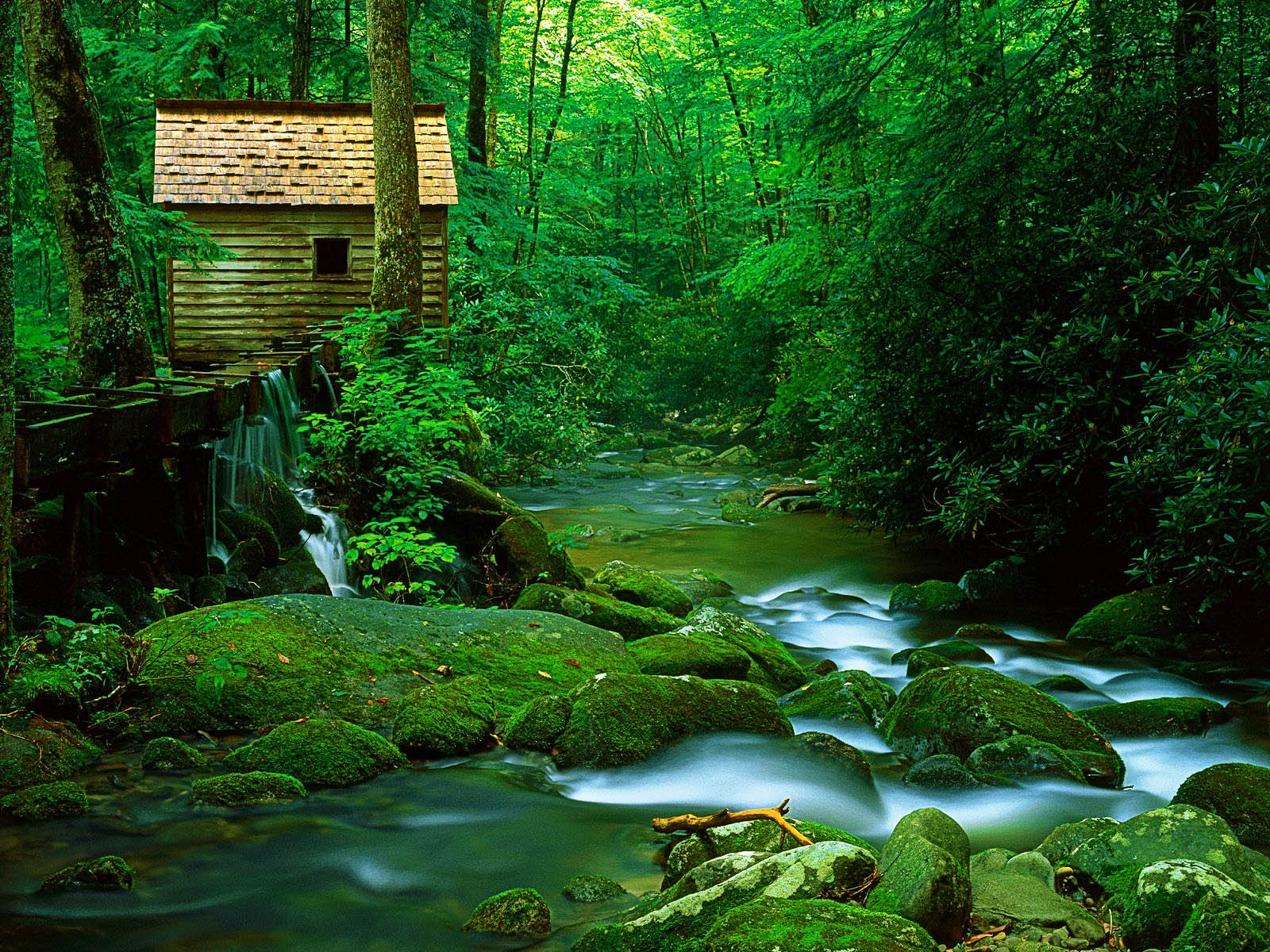What are grist mills?
A gristmill (also: grist mill, corn mill, or flour mill) grinds grain into flour. The term can refer to both the grinding mechanism and the building that holds it.
Are There Grist Mills in the Smokies?
Four grist mills remain within the Great Smoky Mountains National Park. Mingus Mill, a half-mile from the Oconaluftee Visitor Center in North Carolina, is the grandest. Park millers still produce cornmeal in the three-story building as they tell stories of old-time mills and millers. Cable Mill in Cades Cove is a classic small mill with its picturesque waterwheel and tree-shaded millrace. It millers, too, grind grain the old-fashioned way. Ogle and Reagan mills, near Gatlinburg, are examples of the little tub mills once built along mountain streams throughout the Smokies.
Mingus Mill - a historic "Grist" mill, built in 1886, still functional today.
Rehabilitated by the National Park Service in 1968, located not far from "Mountain Farm Museum" on the Cherokee NC side of Rte 441 which runs through the national park.
Cornmeal and other mill-related items can be found for sale in the mill house. Walk the path along the "millrace" as the water races towards the historic mill. Make time to explore Smoky Mountains settlers' history with a tour of this working mill. With easy access and family-friendly atmosphere, return to the times past. It is also a nice place for wildflowers in the spring & summer months. Stop in the mill house to chat with a local volunteer or "miller" that can tell you even more about the history of this place. You can even purchase mill-related items like actual cornmeal. The mill was used to make cornmeal as well as wheat flour that supplied the small community located near Mingus Creek with food.

Cool facts:
- The Mingus Mill you tour today is nestled among trees, but when it was built, it was surrounded by cleared fields and crops.
- The Mingus family, who moved into the Oconaluftee Valley in the 1790s, probably built an earlier mill on this site.
- The present structure was completed in 1886.
- The mill's distinction was its metal turbine, an improvement on the traditional wooden waterwheel that made Mingus Mill one of the most advanced in the Smokies at the time.
DISTANCE: From Cherokee NC - 2.5 miles; From Gatlinburg, TN - 29.5 miles
Cable Mill in Cades Cove.
John Cable built his mill in the early 1870s at the west end of Cades Cove, it was surrounded only by his fields at the time. Like most farmers with gristmills, Cable's milling was a part-time job. Although the mill was open for business on specific days, customers who came at other times could ring a large bell near the mill when they wanted to call John Cable from his fields. Today, Cable Mill has a visitor center plus the Gregg-Cable House and several farm buildings which were moved in from other parts of the cove.
Cool facts:
- Cable Mill is one-fourth the size of Mingus Mill.
- It is a two-story structure about consists of an 18- by 20-foot room divided into two: an open space at ground level where customers waited with their grain and a raised platform holding the mill equipment.
- Beneath the main floor, an unfinished basement houses the gears that move energy from the waterwheel to the millstones.
- Cable Mill's power comes from Mill Creek, although Cable dug a connecting channel to Forge Creek so that when water levels were low he could tap both streams. A low dam channels water toward the head of the millrace where the first of several water gates allows the miller to regulate the flow of water. The last water gate, on the flume, can be operated by a long lever from within the mill.
- Eleven feet high and five feet wide between its rims, the Cable waterwheel is a classic overshot wheel suited to fast mountain streams. Undershot wheels, used on slow, flat-water rivers of the lowlands, turned as water flowed past the bottom of the wheel. Much more energy-efficient, overshot wheels took advantage of mountain streams plunging down steep grades.
- When water hits the overshot wheel at full surge, Cable Mill can produce three bushels (150 pounds) of meal per hour. As the waterwheel turns, its voice as soothing as the sound of running water, the miller pours corn into a two-foot square hopper. The hopper drops kernels into a "shoe," a narrow chute that feeds the corn through a hole in the top millstone.
From Gatlinburg TN, enter the National Park from the Parkway (the main street) in Gatlinburg. Turn right at Sugarlands Visitor Center. Travel 13 miles to the Wye (swimming hole) in Townsend. Continue straight 7.6 miles where you will go directly into the Cades Cove entrance. The mill is about 5.5 miles from that point.
Ogle Mill.


Take an easy 1/4 mile walk from Noah "Bud" Ogle Place (on Cherokee Orchard Road) past the rock walls of a former pasture to the Ogle tub mill. Now hidden among trees next to LeConte Creek, the mill was part of the Ogle farmstead which included a house, barn, orchard, garden, and a "weaner" cabin for newlywed offspring. Ogle's Mill was a rough-cut tub mill built in the 1880s. Hollowed-out logs serve as the flume and the eleven-foot square mill building is a crib of hand-split logs. The open spaces between the logs provided the only light shed on the small, 22-inch millstones. The mill was restored to its operational condition in the 1960s.
In Downtown Gatlinburg turn onto Airport Rd/Historic Nature Trail. Travel 2.2 miles to the entrance of Cherokee Orchard Road. Stop by Ogle's place, and then continue driving down the nature trail - a one-way road that runs for 8 miles. May be seasonally closed.
Reagan Mill.
Alfred Reagan who built the mill in 1895 was not only a farmer but also had a blacksmith shop and a store and served as a preacher and a carpenter.
Reagan Mill (alongside Roaring Fork Motor Nature Trail) is a good example of the tub mills that once were a common sight near the streams all over the Appalachians. Tub mills were well suited to mountainous terrain because they captured energy from relatively low-volume, high-velocity streams. They were small enough to fit easily along narrow stream banks

These mini-mills were so popular that as many as 14 once lined Gatlinburg's, LeConte Creek. A tub mill like Reagan Mill could produce about a bushel of cornmeal a day.
In Downtown Gatlinburg turn onto Historic Nature Trail (which may be seasonally closed in winter) and travel 2.2 miles to the entrance of Cherokee Orchard Road. This driving trail is a one-way road that runs for 8 miles. Reagan Mill at the end of the trail.